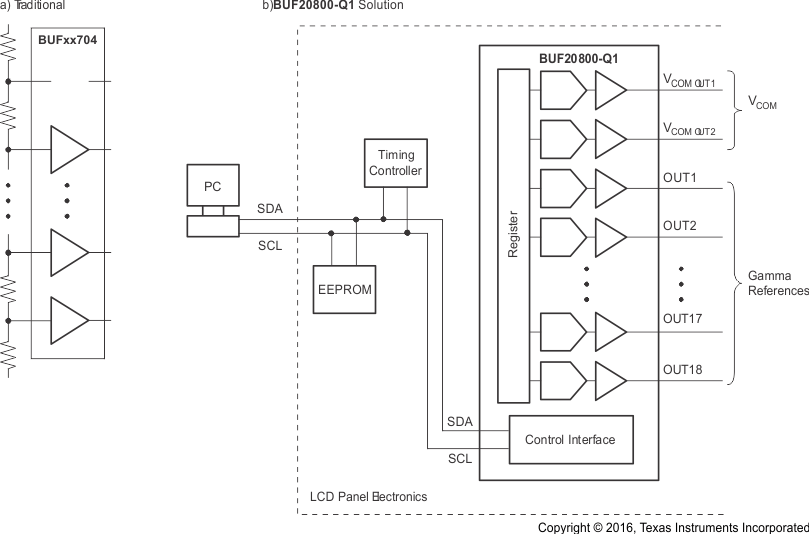SBOS571C August 2011 – August 2018 BUF20800-Q1
PRODUCTION DATA.
- 1 Features
- 2 Applications
- 3 Description
- 4 Revision History
- 5 Pin Configuration and Functions
- 6 Specifications
- 7 Detailed Description
- 8 Application and Implementation
- 9 Power Supply Recommendations
- 10Layout
- 11Device and Documentation Support
- 12Mechanical, Packaging, and Orderable Information
Package Options
Mechanical Data (Package|Pins)
- DCP|38
Thermal pad, mechanical data (Package|Pins)
- DCP|38
Orderable Information
7.4.1 Replacement of Traditional Gamma Buffer
Traditional gamma buffers rely on a resistor string (often using expensive 0.1% resistors) to set the gamma voltages. During development, the optimization of these gamma voltages can be time-consuming. Programming these gamma voltages with the BUF20800-Q1 can significantly reduce the time required for gamma voltage optimization. The final gamma values can be written into an external EEPROM to replace a traditional gamma buffer solution. During power-up of the LCD panel, the timing controller reads the EEPROM and loads the values into the BUF20800-Q1 to generate the desired gamma voltages. Figure 10a shows the traditional resistor string; Figure 10b shows the more efficient alternative method using the BUF20800-Q1.
BUF20800-Q1 uses the most advanced high-voltage CMOS process available today, which allows it to be competitive with traditional gamma buffers.
This technique offers significant advantages:
- It shortens development time significantly.
- It allows demonstration of various gamma curves to LCD monitor makers by simply uploading a different set of gamma values.
- It allows simple adjustment of gamma curves during production to accommodate changes in the panel manufacturing process or end-customer requirements.
- It decreases cost and space.
 Figure 10. Replacement of the Traditional Gamma Buffer
Figure 10. Replacement of the Traditional Gamma Buffer